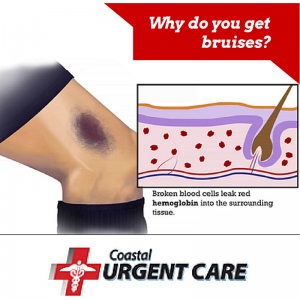 Lots of daily mishaps can result in the formation of a bruise. Although the pain only last for a few minutes or sometimes not at all, you’ll be wearing that ugly bruise as a reminder of your blunder for a while. But what causes your skin to turn back and blue?
Lots of daily mishaps can result in the formation of a bruise. Although the pain only last for a few minutes or sometimes not at all, you’ll be wearing that ugly bruise as a reminder of your blunder for a while. But what causes your skin to turn back and blue?
A bruise, or contusion, happens when a part of the body is struck and the muscle fibers and connective tissue underneath are crushed but the skin doesn’t break. When this occurs, blood from the ruptured capillaries near the skin’s surface escapes by leaking out under the skin. With no place to go, the blood gets trapped, forming a red or purplish mark that’s tender when you touch it. Sometimes your skin can become raised when the blood from these vessels ruptures into the surrounding tissues. Most healthy bodies will eventually reabsorb the blood, and the bruise will disappear. In general, the harder your bump or blow, the larger your bruise will be.
How long do bruises last and how do they heal?
You know how a bruise changes color over time? That’s your body fixing the bruise by breaking down and reabsorbing the blood, which causes the bruise to go through many colors of the rainbow before it eventually disappears. You can usually guess the age of a bruise just by looking at its color.
- Brand new – The bruise will appear reddish due to the color of the blood that leaked from the capillaries under the skin.
- One to two days old – The bruise will take on a bluish or purple color. The swelling at the site of the bruise will cause oxygen to be cut off, and hemoglobin, the substance that carries iron in your blood, will turn blue.
- Six days old – The bruise will turn a greenish color as the hemoglobin breaks down and the area begins to heal itself.
- Eight to nine days old – a bruise will then turn yellow or brown. This is the final stage in the body’s re-absorption of the blood.
How can you help bruises at home and when to see a doctor:
It’s hard to prevent bruises, but you can help speed the healing process. When you get a bruise, you can use stuff you find right in your freezer to help the bruise go away faster. Applying cold when you first get a bruise helps reduce its size by slowing down the blood that’s flowing to the area, which decreases the amount of blood that ends up leaking into the tissues. It also keeps the inflammation and swelling down. All you have to do is apply cold to the bruise for 15 to 20 minutes at a time for a day or two after the bruise appears.
Sometimes your bruise doesn’t change color or heal properly. If the bruise remains firm and gets bigger or more painful, a hematoma may have formed. This happens when blood collects under the skin or in the muscle, and instead of trying to fix this, your body walls the blood off. If this happens, you need to have the hematoma drained by a doctor.
Contact or visit your local Coastal Urgent Care if:
- A bruise isn’t improving after 2 weeks.
- You bruise often and bruises seem to develop for no known reasons.
- Your bruise is swelling and very painful.
- You can’t move a joint or you think you may have a broken bone.
- The bruise is near your eye and you have difficulty moving your eyes or seeing.
